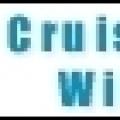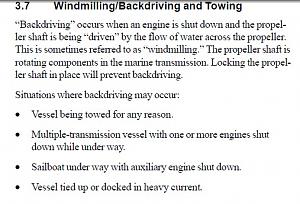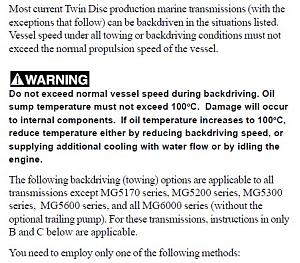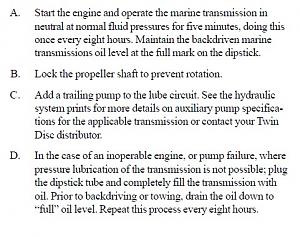 |
|
 11-29-2008, 07:17 PM
11-29-2008, 07:17 PM
|
#1
|
|
Lieutenant
Join Date: Sep 2008
Posts: 41
|
When the yacht is sailing well at say 5 knots the prop can be rotating at quite a speed. Question is, is it better to "lock " the propshaft or let it spin? My thoughts are while it spins it may be wearing the gearbox and shaft bearings unecessarily, noisy too!
If I put the engine control in REVERSE the shaft stops rotating but is this undue pressure on the gearbox?
Any comments please?
Cheers,
Alan 
__________________
|

|

|
 11-29-2008, 07:46 PM
11-29-2008, 07:46 PM
|
#2
|
|
Moderator
Join Date: Jun 2007
Home Port: Washington DC
Vessel Name: SV Mahdee
Posts: 3,236
|

Quote:
Originally Posted by alan

When the yacht is sailing well at say 5 knots the prop can be rotating at quite a speed. Question is, is it better to "lock " the propshaft or let it spin? My thoughts are while it spins it may be wearing the gearbox and shaft bearings unecessarily, noisy too!
If I put the engine control in REVERSE the shaft stops rotating but is this undue pressure on the gearbox?
Any comments please?
Cheers,
Alan  |
Hi, Alan,
Some transmissions can be damaged by prop freewheeling, others not. For example, our Hurth HSW800 can freewheel with no problems--thus we intend to install a prop-shaft generator at some point (to obtain a bit of charging from all that spinning). If your tranny can be damaged by the freewheeling, by all means, lock it down with a proper system for that purpose.
What kind of tranny do you have make/model? Do you have owner/op manual that tells you if it can be free wheeled? You could call the mfr. rep in your area to find out. Damage can occur if the tranny doesn't have sufficient lubrication with the free spinning prop. So, it comes down to the type of lube system (e.g. does the engine have to be on driving a pump?) it has.
Fair winds,
Brenda
__________________
|

|

|
 11-29-2008, 08:13 PM
11-29-2008, 08:13 PM
|
#3
|
|
Lieutenant
Join Date: Sep 2008
Posts: 41
|
Hi Brenda,
Thanks for your prompt reply. The motor is a 2 yr old Yanmar 3YM30 (30 hp) with as far as I can determine a standard marine gear incorperated with that motor. If I put it forward gear when sailing it still rotates the prop, only reverse gear stops the shaft rotating.
This to my way of thinking should cause no concern, however I'm no mechanic!
Cheers,
Alan 
__________________
|

|

|
 11-29-2008, 08:59 PM
11-29-2008, 08:59 PM
|
#4
|
|
Commander
Join Date: Mar 2007
Posts: 129
|
Look at your operating manual for the engine/transmission and it will specifically state whether the proper can free-wheel or needs to be locked so it cannot rotate.
If you lost the manual consult the engine/transmission manufacturer on-line or call them. Serious damage can be done to your transmission if it free-wheels for long periods of time and needs "cooling" that can only be gotten when the engine is operating.
__________________
|

|

|
 12-01-2008, 01:44 PM
12-01-2008, 01:44 PM
|
#5
|
|
Commander
Join Date: Jul 2008
Posts: 120
|
I have always understood that a rotating prop (surprisingly) causes more drag than a fixed prop... Anyone got any knowledge on that?
__________________
Regards
Ed
Delivering boats for a living
+44 (0) 7932039727
|

|

|
 12-01-2008, 07:05 PM
12-01-2008, 07:05 PM
|
#6
|
|
Moderator
Join Date: Jun 2007
Home Port: Washington DC
Vessel Name: SV Mahdee
Posts: 3,236
|

Quote:
Originally Posted by edsailing

I have always understood that a rotating prop (surprisingly) causes more drag than a fixed prop... Anyone got any knowledge on that?
|
Lots of arguments on that one.
If its a two bladed prop that can be blanketed in the stream of moving water by the hull, then, yes, having it fixed makes sense.
Assuming a 3 blade (like ours) which can't hide from the water stream behind the hull or assuming a strut and no big keel to help out...then I would think:
If a prop is just sitting there fixed, it dissipates the energy by creating a big turbulence pattern. If the prop is spinning, then some of the energy is turned into rotating the prop--thus less turbulence, smoother flow, should be less drag.
Again, lots and lots of arguments on this one.
My own personal interest is in the fact that one can employ a prop shaft generator and charge one's batteries using the the turning of the prop rather than throwing a water turbine in the water which does the same thing while underway. 
|

|

|
 12-01-2008, 08:33 PM
12-01-2008, 08:33 PM
|
#7
|
|
Moderator/Wiki Sysop
Join Date: Apr 2008
Home Port: Samos
Vessel Name: S/Y Thetis
Posts: 559
|
Quote:
Originally Posted by alan

The motor is a 2 yr old Yanmar 3YM30 (30 hp) with as far as I can determine a standard marine gear incorperated with that motor. If I put it forward gear when sailing it still rotates the prop, only reverse gear stops the shaft rotating.
|
I too have a 3YM30. I just did a search in it manual and there is no advise on what to do when sailing. For whatever it is worth I do put it in reverse for all the reasons already mentioned in this thread.
Vasilis
 : Mediterranean, Black Sea, Atlantic |

|

|
 12-03-2008, 12:55 AM
12-03-2008, 12:55 AM
|
#8
|
|
Lieutenant
Join Date: Sep 2008
Posts: 41
|
Well ladies and gentlemen, here is the word from the master of all things mechanical! Quote from Boat Owners Mechanical & Electrical Manual by Nigel Calder.
" When a boat is under sail or tow, propeller drag will cause the propeller to freewheel unless the shaft is braked. A freewheeling propeller will, in many instances create more drag than a locked one. Some transmissions, such as Deroit Diesels will burn out due to lack of oil ciculation, while in all installations additional and unnecessary wear will occur to cutlass bearings, stuffing boxes, transmission oilseals and bearings. Freewheeling propellers can also make quite a racket.
When the engine has a manual transmission the shaft can be locked simply by putting it into gear. This will not work with a hydraulic box however since there is no oil pressure for gear shifting when the engine is shut down. A shaft brake is needed"
I will now continue to select reverse gear when sailing, enlightened!
Cheers,
Alan 
__________________
|

|

|
 12-03-2008, 04:51 AM
12-03-2008, 04:51 AM
|
#9
|
|
Lieutenant
Join Date: Feb 2007
Home Port: Port Huron
Posts: 44
|
"A freewheeling propeller will, in many instances create more drag than a locked one."
I know very little about boats... but I know my car tires create more drag with the brakes are applied.
I am trying to think of an instance that a stopped propeller creates less drag than one being spun. I wish that guy would have given an example of the "many instances".
I thought the laws of physics were constant.
|

|

|
 12-03-2008, 09:58 AM
12-03-2008, 09:58 AM
|
#10
|
|
Lieutenant
Join Date: Sep 2008
Posts: 41
|
Duane, I kind of see the point you are making but for me, even if the drag equates the same when locked or revolving, the other issues like wear and tear on bearings, seals, cutlass and stuffing box, plus when you are trying to sleep, off watch, listening to the spinning propshaft, "LOCKED" is the only way for me!
Cheers,
Alan 
" Anything I've ever done that was ultimately worthwhile,
Initially scared me to death" Betty Bender
__________________
|

|

|
 12-03-2008, 02:25 PM
12-03-2008, 02:25 PM
|
#11
|
|
Lieutenant
Join Date: Feb 2007
Home Port: Port Huron
Posts: 44
|
Now I can understand that! 
|

|

|
 12-03-2008, 04:33 PM
12-03-2008, 04:33 PM
|
#12
|
|
Moderator
Join Date: Jun 2007
Home Port: Washington DC
Vessel Name: SV Mahdee
Posts: 3,236
|

Quote:
Originally Posted by alan

Duane, I kind of see the point you are making but for me, even if the drag equates the same when locked or revolving, the other issues like wear and tear on bearings, seals, cutlass and stuffing box, plus when you are trying to sleep, off watch, listening to the spinning propshaft, "LOCKED" is the only way for me!
|
Hi, Alan, I believe Caulder is doing what he usually does which is state a conservative case. This, I like about Caulder since in general I believe one won't get into trouble following Caulder's advice, but many time Caulder over-simplifies for his audience. This issue is not a one-size-fits-all that suits Caulder's style as well as some other issues.
Here in the passage you've quoted he says: " When a boat is under sail or tow, propeller drag will cause the propeller to freewheel unless the shaft is braked. A freewheeling propeller will, in many instances create more drag than a locked one."
the "in many instances" greatly simplifies things. As I mentioned, for example, two bladed props which can be stopped in a position to "hide" behind the keel can create less drag when locked. There are "many instances" in which the locked prop will create more drag than the free wheeling one--but in this passage Caulder is building his case for the locked prop so of course he's not going to get into those instances which do not support the case. 
Caulder goes on to say: "Some transmissions, such as Deroit Diesels will burn out due to lack of oil ciculation,"
The key word here is "some" transmissions. Not all, but "some." I concur with Caulder on this; most important--one needs to understand how the oil is circulated in the transmission. If one doesn't, then, one should lock the prop "just in case."
Caulder then notes: "while in all installations additional and unnecessary wear will occur to cutlass bearings, stuffing boxes, transmission oilseals and bearings."
The important thing here is "unnecessary" wear. If one is letting the shaft spin because in their particular case it creates LESS drag and one happens to be, say, racing? Well, then one might not call it "unnecessary" wear. Further, if one is letting the shaft spin because one is using a prop shaft generator to charge batteries (as we intend), again, one would not consider the wear "unnecessary" but a part of that electricity generation.
Strengthening the case for locking down the prop, Caulder states: "Freewheeling propellers can also make quite a racket."
Well, key word here is "can" make a racket. Not all freewheeling props make a racket. The freewheeling prop on our Rawson 30 Volvo engine was silent--and we let it freewheel because we didn't mark the prop shaft to let us know when the two blade prop would be hidden behind the keel and when its blades would stick out like a couple of wing-nuts adding much turbulence.
There is nothing "absolutely" right or wrong about locking down the prop shaft. I took the time to write this little analysis of Caulder's position...not because I really disagree with him, I don't...rather because far too many people take Caulder's word to be gospel (and it certainly is not). When one does this, one can quite cheerily remain in the dark about how things really work. Sometimes one's own situation is outside of the 80% rule that Caulder seems to be working within.
Best of luck to you. 
|

|

|
 12-03-2008, 10:42 PM
12-03-2008, 10:42 PM
|
#13
|
|
Admiral
Join Date: Oct 2004
Posts: 3,067
|
To Freewheel or not to Freewheel - surely it depends?, as always - when discussing things pertaining to sailboats. Surely there is no one rule that fits all.
Which gearbox? How many blades on the prop? What pitch ? Is prop enclosed ? What width of keel ahead of the prop ? Does the Prop Shaft have pillar block bearings? etc... not to exclude ' what combination of any or all of the above'
Finally what does the the gearbox op-manual say on the matter, since it is common cause that the practice of freewheeling in certain types of transmissions has the greatest negative potential on the gearbox itself rather than on the rest of the drive train. Nigel Calder's contributions to cruising over the last thirty odd years have extraordinary merit.
__________________

|

|

|
 12-04-2008, 12:30 AM
12-04-2008, 12:30 AM
|
#14
|
|
Lieutenant
Join Date: Sep 2008
Posts: 41
|
Thankyou indeed for the detailed clarification. I must say Calders advice suits my situation, My 3 cylinder Yanmar has a manual marine box, my propeller is a 3 bladed one, the shaft rotating makes a noise and to my understanding, in the process is possibly causing undue wear on cutlass, stuffing box, bearings and seals. In cruising mode, as I am, it makes a lot of sense to me to keep wear and hence repairs to a minimum.
By the way I love your Yoda quote, terriffic!
Cheers,
Alan
"Twenty years from now you will be more dissappointed with the things you didn't do rather than the ones you did do. So throw off the bowlines,sail away from safe harbour. Catch the tradewinds in your sails. Explore, dream, discover!" Mark Twain
__________________
|

|

|
 12-04-2008, 03:39 PM
12-04-2008, 03:39 PM
|
#15
|
|
Lieutenant
Join Date: Feb 2007
Home Port: Port Huron
Posts: 44
|
Quote:
Originally Posted by MMNETSEA

To Freewheel or not to Freewheel - surely it depends?, as always - when discussing things pertaining to sailboats. Surely there is no one rule that fits all.
Which gearbox? How many blades on the prop? What pitch ? Is prop enclosed ? What width of keel ahead of the prop ? Does the Prop Shaft have pillar block bearings? etc... not to exclude ' what combination of any or all of the above'
Finally what does the the gearbox op-manual say on the matter, since it is common cause that the practice of freewheeling in certain types of transmissions has the greatest negative potential on the gearbox itself rather than on the rest of the drive train. Nigel Calder's contributions to cruising over the last thirty odd years have extraordinary merit.
|
Thanks for clearing up the "many circumstances" question I had.
|

|

|
 12-05-2008, 08:03 AM
12-05-2008, 08:03 AM
|
#16
|
|
Commander
Join Date: Jul 2008
Posts: 120
|
Another quick thought.
A spinning prop is far more likely to get fouled than a static one.
I am definitely an 'Engage Reverse' man!
__________________
Regards
Ed
Delivering boats for a living
+44 (0) 7932039727
|

|

|
 01-03-2009, 02:52 AM
01-03-2009, 02:52 AM
|
#17
|
|
Ensign
Join Date: Jan 2009
Posts: 20
|

Quote:
Originally Posted by Duane2312

"A freewheeling propeller will, in many instances create more drag than a locked one."
I know very little about boats... but I know my car tires create more drag with the brakes are applied.
I am trying to think of an instance that a stopped propeller creates less drag than one being spun. I wish that guy would have given an example of the "many instances".
I thought the laws of physics were constant.
|
I work with an old(er) Naval architect and he has more old rules and anecdotes such as spinning wheels and drag and he always cites several instances from past tests that he can't give exact details about he just knows that what he's saying is the last word!
I own a substantial marine library as I suspect many of you here do also and there are more authors making statements of fact with no corroborating facts on all subjects relating to boats.
My 12 year old was at the helm and I told him to shift the transmission into neutral when he shut down the engine.
His asked why.
I said because it would hurt the gears to turn while the engine was off.
He asked why.
I said because there wouldn't be sufficient lubrication.
He asked why and how do I know.
I looked in the manual and no place does it say that.
As someone who has to answer questions relating to warranty of our products I know how important it is to have all questions answered by the O&M manual.
If the gears could be hurt from turning under sail without the engine running you would think it would be in bold print someplace to lock the shaft.
My manual doesn't say it.
I still shift into reverse because.....I heard from someone or read that you should do that.
That doesn't make it true.
__________________
Bill and Sali
CSY 44
Silent Option
|

|

|
 04-20-2009, 05:11 PM
04-20-2009, 05:11 PM
|
#18
|
|
Retired Mod
Join Date: Mar 2007
Home Port: Durban
Posts: 2,984
|
Another great job by "Maine Sail":
<object width="425" height="355"><param name="movie" value="http://www.youtube.com/v/jI-UG9RSlJo&hl=en"></param><param name="wmode" value="transparant"></param><embed src="http://www.youtube.com/v/jI-UG9RSlJo&hl=en" type="application/x-shockwave-flash" wmode="transparant" width="425" height="355"></embed></object>
 : Most sections |

|

|
 04-21-2009, 12:34 AM
04-21-2009, 12:34 AM
|
#19
|
|
Moderator
Join Date: Jun 2007
Home Port: Washington DC
Vessel Name: SV Mahdee
Posts: 3,236
|
I love it  Great little movie. I'm an advocate for the theory that in general free wheeling props create less drag than a locked prop so glad to see the video shows an example where this is true. The opposite would likely be true in a few special cases...for example...if one has a full keel sailboat with a two blade prop that can be locked with the blades hidden behind the keel from the free flow of water.
Great "myth buster" type movie.
|

|

|
 04-21-2009, 02:27 AM
04-21-2009, 02:27 AM
|
#20
|
|
Admiral
Join Date: Oct 2004
Posts: 3,067
|
True the video clip does illustrate the theory very clearly that freewheeling (windmilling) produces less drag when using a RIB.
What is important to a Sailboat is the effect on the boat's transmission, coupling, prop shaft and bearings.
TMC and ZF gearboxes amongst others, where the clutches are hydraulically operated, require the transmission oil to be cooled - this process is enabled by utilizing the engine's oil cooling system via the Engines heat exchanger. When the engine is shut down and the propeller allowed to freewheel (to windmill, to backdrive), the components in the transmission will turn and heat up.
Extracts from Twindisk Technodrive - PDF manual #1016313 entitled "Marine Transmissions Owners Manual; relevant to this discussion :-



What is necessary on all Hydraulically operated transmissions is knowing the transmission's oil pressure and temperature. Most modern ones have the facility to fit appropriate gauges and warning devices.
__________________
__________________

|

|

|
 |
|
|
Currently Active Users Viewing This Thread: 1 (0 members and 1 guests)
|
|
|
 Posting Rules
Posting Rules
|
You may not post new threads
You may not post replies
You may not post attachments
You may not edit your posts
HTML code is Off
|
|
|
|
 Recent Threads
Recent Threads |
|
|
|
|
|
|
|
|
|
|
|
|
|
|
|
|
|
|
|
|
|
|
|













 Linear Mode
Linear Mode






























